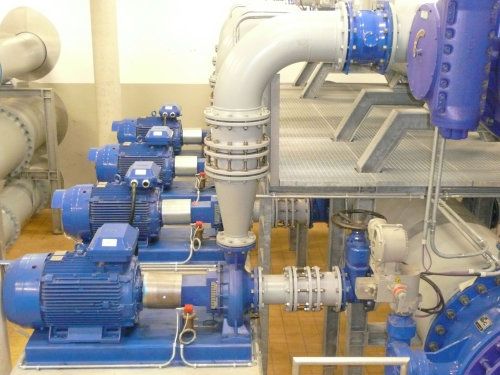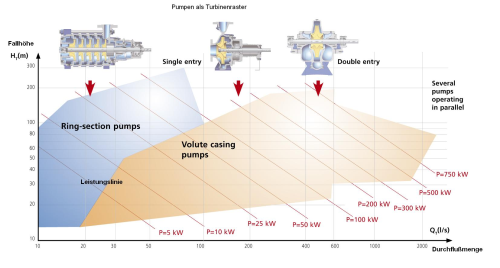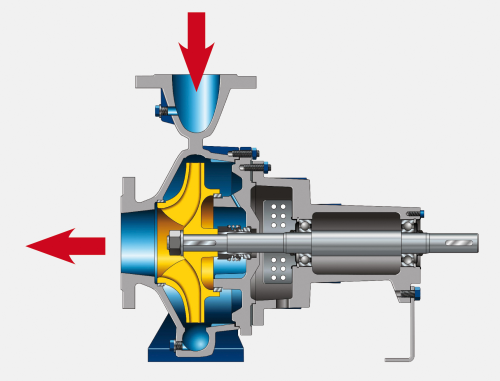


The concept of running a centrifugal pump in reverse rotation mode has been recognised by pump manufacturers for many years and within the water supply industry this concept has been exploited to a limited degree as a means of generating power in locations where it is considered too expensive to purchase a hydro turbine. It has not gone unnoticed by water suppliers, operators of small hydropower plants and pump manufacturers that running pumps as turbines (PaTs) is an efficient method of generating energy as well as recovering energy and contributing to energy savings. In the current world economic climate where reducing energy costs is becoming a high priority it is not surprising that PaTs are starting to create significant interest.
KSB Aktiengesellschaft is one of a group of pump manufacturers that is active in investing resources in PaTs and the company has recorded considerable success with its solutions in several parts of the world. Applications where KSB already has pump units on PaTs duties include small hydropower systems (<10 MW), major water transport systems, reverse osmosis and industrial systems where the technology can be employed as an alternative to throttling devices.
“KSB has been active in supplying volute casing and ring-section pumps for PaTs duties over several years, mostly into the small end of the hydropower market, “says Sander Klos, KSB’s senior project manager, Small Hydropower. “In the small end market power requirements are typically up to100 kW, but the investment costs are relatively high for conventional hydropower units and the payback period can be as high as 15 years. With our PaTs solution, the payback period can be as short as three years and there is the added benefit that pumps are less complicated to operate than turbines.”
He continues: “For locations where there is a relatively constant water supply but power supplies are unreliable or even non-existent, PaTs are a simple and economic approach to generating power. Not only that, PaTs can also have a role to play in locations where the power supply is readily available and reliable. KSB is now supplying systems for very large water supply infrastructures which traditionally have been the domain of conventional hydroturbines. Here the power being generated is contributing to the overall running costs of the water pumping stations and putting power back into the national grid.”
Identifying the potential for running pumps as turbines originated through users in the water industry wanting to know what the impact would be on their systems should a pump stop and then go into reverse operation. This was a scenario which was raised with KSB and in response its hydraulics engineering department was brought in to examine this issue and to calculate the turbine performance curves of pumps when running in reverse. They discovered that the behaviour of the pump running as a turbine is very good as the energy output could be higher than the energy input used to run it as a pump.
Hydraulically, the pump in turbine mode can handle a higher volume of water than when in conventional pumping mode. There is a higher flow inside the pump and this means that the amount of energy that comes out is higher. An added bonus is that when it is in reverse operation and running as a turbine the pump runs more efficiently than in conventional mode. The operating range for ring section and volute casing pumps is illustrated in Figure 1.
With the pump running in reverse, the shaft torque can be utilised in a number of ways. When attached to a generator it is the mains frequency that determines the speed. In such a scenario to generate a frequency of 50 Hz the pump as turbine would have to run at a rate of ~1515 rpm (a little over-speed). Incorporating frequency inverters and appropriate mains feed circuitry would create greater speed variation without adding very much cost to the package. It can be seen, therefore, that this is a very cost-effective way of generating power even when compared to the higher efficiencies of a conventional turbine.
An alternative application would be to connect a Pat directly to a driven machine, another pump being an example, which does not have either a motor or generator to fix the speed. This mechanical solution to providing energy has been successfully supplied by KSB to locations in many parts of the world where a power supply is not available for operating water distribution/transfer pumps but there is sufficient energy in head of water to drive the PaT.
In order for this type of unit to operate effectively both the PaT and pump must have ‘equal output’ at both ends of their shafts, which means that they must be rigidly connected to each other by couplings or a gearbox. If the Pat does not have sufficient strength, then the pump to which it is connected will not be able to provide the necessary discharge head. On the other hand, if it is too strong, the Pat will either waste energy or overload the pump.
Because of its exposure in all sectors of the global water supply industry, KSB has products that have been proven over many years. Pumps that the water industry will be more than familiar with are the Omega, Etanorm, Multitec and RDL ranges and it is these products that KSB is advocating for hydropower duties for heads above 10 m. Where the head is below 10m and flow rates are high, then axial flow pumps provide the most effective solution. The scope and operating capabilities of these pumps has enabled KSB to establish a business sector dedicated to designing PaT modules which can be used in single and multiple configurations (see figure 2).
The capability to operate multiple PaT modules is highly relevant for locations where the water supply can fluctuate. Unlike conventional turbines, PaTs do not have adjustable guide vanes for adapting to fluctuations in the water supply and this is perceived as a drawback to their use. By employing a number of differently sized units to distribute the total volume of water available, this difficulty can be overcome.
According to KSB, running several units requires only the minimum of control and although this type of arrangement does diminish the cost advantage of the PaT over the use of a single turbine, it remains advantageous in terms of appropriate technology. Quite simply, pumps are easier to operate and maintain that conventional turbines.



